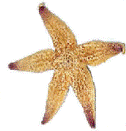Department of Chemistry
Date of this Version
5-2008
Abstract
Marine invertebrates employ external fertilization to take the advantages of sexual reproduction as one of excellent survival strategies. To prevent mismatching, successful fertilization can be made only after going though strictly defined steps in the fertilization. In sea stars, the fertilization process starts with the chemotaxis of sperm followed by hyperactivation of sperm upon arriving onto the egg coat, and then sperm penetrate to the egg coat before achieving the fusion. To investigate whether the initiation of chemotaxis and the following signaling has species specificity, we conducted comparative studies in the protein level among sea stars, Asterias amurensis, A. forbesi, and Asterina pectinifera. Since transcription of messenger ribonucleic acid (mRNA) has been suppressed in gamete, the roles of sperm proteins during the fertilization cannot be investigated by examining the mRNA profile. Therefore, proteomics analysis by mass spectrometry was used in this study. In sea stars, upon receiving asteroidal sperm-activating peptide (asterosap), the receptor membrane-bound guanylate cyclases in the sperm tail trigger sperm chemotaxis. We confirmed the presence of membrane-bound guanylate cyclases in the three sea star species, and they all had the same structural domains including the extracellular domain, kinase-like domain, and guanylate cyclase domain. The majority of peptides recovered were from α-helices distributed on the solvent side of the protein. More peptides were recovered from the intracellular domains. The transmembrane domain has not been recovered. The functions of the receptors seemed to be conserved among the species. Furthermore, we identified proteins that may be involved in the guanylate cyclase-triggered signaling pathway.


Comments
Published in Marine Biotechnology: An International Journal Focusing on Marine Genomics, Molecular Biology and Biotechnology 10 (2008), pp. 564–571; doi 10.1007/s10126-008-9096-7 Copyright © 2008 Springer Science+Business Media, LLC. Used by permission.